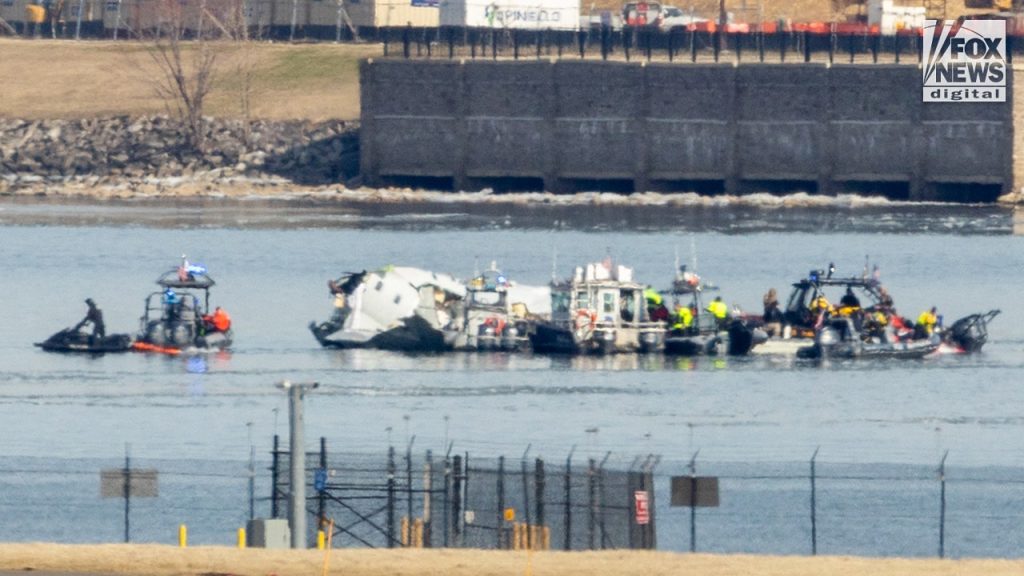The devastating midair collision between a commercial airliner and a Black Hawk helicopter over the Potomac River last week resulted in a massive recovery operation, yielding the heartbreaking discovery of 55 bodies. DC Fire and EMS Chief John Donnelly Sr. confirmed the grim news, highlighting the painstaking efforts undertaken to identify the remains. Remarkably, amidst the tragedy and the physically demanding operation in frigid waters, only one injury was reported – a first responder who suffered from hypothermia but subsequently recovered. The focus now shifts to recovering the submerged wreckage, a complex task scheduled to commence with the delicate lifting of debris from the riverbed.
Colonel Francis Pera of the U.S. Army Corps of Engineers expressed confidence in a successful lift operation, outlining meticulous plans to safeguard any human remains discovered within the wreckage. A protective tent will be erected over the recovered debris on a barge, ensuring the respectful handling of any remains while the wreckage is brought to the surface. This careful approach underscores the sensitivity and reverence with which authorities are managing the recovery process, acknowledging the profound human loss associated with the accident. The entire operation is being closely monitored to ensure the dignified retrieval of any remaining victims.
The collision occurred between a Sikorsky UH-60 Black Hawk helicopter and a Bombardier CRJ700 airliner operated by PSA Airlines, a subsidiary of American Airlines. Preliminary findings from the plane’s flight data recorder revealed the aircraft was struck at an altitude of approximately 325 feet. Significantly, the data also indicated a change in the plane’s pitch shortly before impact, suggesting a possible upward maneuver. This crucial information will be further analyzed in conjunction with data from the Black Hawk’s recorder to provide a more comprehensive understanding of the events leading to the collision.
While air traffic control data initially placed the plane’s altitude at 200 feet at the moment of impact, discrepancies between this data and the flight recorder information require further investigation. NTSB member Todd Inman emphasized the need for more granular data to reconcile this difference and gain a clearer picture of the aircraft’s trajectory in the moments before the collision. Obtaining and analyzing the data from the Black Hawk’s recorder is crucial to corroborating the flight data recorder’s findings and providing a definitive account of the events.
The complexity and scale of the recovery operation were unprecedented, challenging even the most experienced first responders. Jake Crockett, a firefighter and diver with extensive experience, described the operation as “incredibly unusual,” highlighting the stark contrast between typical dive rescues involving one or two victims and the magnitude of this tragedy with 67 lives lost. The sheer number of victims, combined with the need to recover two aircraft and a vast field of debris, presented an extraordinary challenge to the recovery teams. Furthermore, the conditions of the Potomac River, with near-zero visibility and frigid temperatures, added another layer of difficulty to the already complex task.
The dark, murky waters of the Potomac presented significant obstacles for divers tasked with locating and retrieving small aircraft parts. Divers were forced to rely on touch and feel in the near-zero visibility conditions, making the search for remains and debris a painstakingly slow and challenging process. The cold water temperatures also posed a threat to the divers’ safety, necessitating frequent rotations and meticulous safety protocols. Despite these daunting challenges, the recovery teams demonstrated remarkable resilience and dedication, working tirelessly to recover the victims and bring closure to their families. The investigation into the cause of the collision is ongoing, with authorities meticulously analyzing all available data to piece together the events that led to this heartbreaking tragedy.










